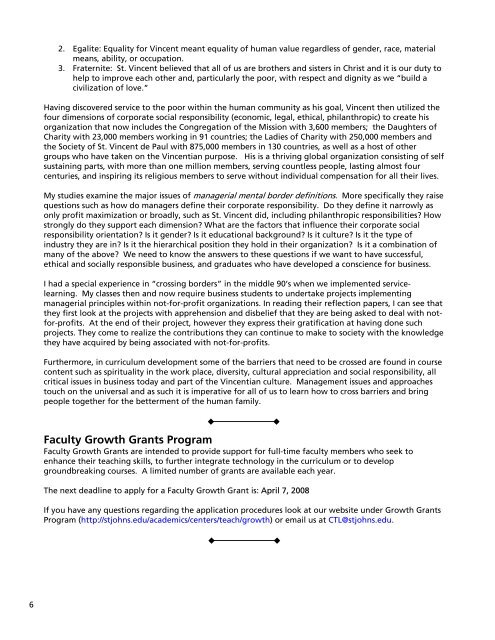Center for Teaching and Learning - St. John's University
Center for Teaching and Learning - St. John's University
Center for Teaching and Learning - St. John's University
You also want an ePaper? Increase the reach of your titles
YUMPU automatically turns print PDFs into web optimized ePapers that Google loves.
6<br />
2. Egalite: Equality <strong>for</strong> Vincent meant equality of human value regardless of gender, race, material<br />
means, ability, or occupation.<br />
3. Fraternite: <strong>St</strong>. Vincent believed that all of us are brothers <strong>and</strong> sisters in Christ <strong>and</strong> it is our duty to<br />
help to improve each other <strong>and</strong>, particularly the poor, with respect <strong>and</strong> dignity as we “build a<br />
civilization of love.”<br />
Having discovered service to the poor within the human community as his goal, Vincent then utilized the<br />
four dimensions of corporate social responsibility (economic, legal, ethical, philanthropic) to create his<br />
organization that now includes the Congregation of the Mission with 3,600 members; the Daughters of<br />
Charity with 23,000 members working in 91 countries; the Ladies of Charity with 250,000 members <strong>and</strong><br />
the Society of <strong>St</strong>. Vincent de Paul with 875,000 members in 130 countries, as well as a host of other<br />
groups who have taken on the Vincentian purpose. His is a thriving global organization consisting of self<br />
sustaining parts, with more than one million members, serving countless people, lasting almost four<br />
centuries, <strong>and</strong> inspiring its religious members to serve without individual compensation <strong>for</strong> all their lives.<br />
My studies examine the major issues of managerial mental border definitions. More specifically they raise<br />
questions such as how do managers define their corporate responsibility. Do they define it narrowly as<br />
only profit maximization or broadly, such as <strong>St</strong>. Vincent did, including philanthropic responsibilities? How<br />
strongly do they support each dimension? What are the factors that influence their corporate social<br />
responsibility orientation? Is it gender? Is it educational background? Is it culture? Is it the type of<br />
industry they are in? Is it the hierarchical position they hold in their organization? Is it a combination of<br />
many of the above? We need to know the answers to these questions if we want to have successful,<br />
ethical <strong>and</strong> socially responsible business, <strong>and</strong> graduates who have developed a conscience <strong>for</strong> business.<br />
I had a special experience in “crossing borders” in the middle 90’s when we implemented servicelearning.<br />
My classes then <strong>and</strong> now require business students to undertake projects implementing<br />
managerial principles within not-<strong>for</strong>-profit organizations. In reading their reflection papers, I can see that<br />
they first look at the projects with apprehension <strong>and</strong> disbelief that they are being asked to deal with not<strong>for</strong>-profits.<br />
At the end of their project, however they express their gratification at having done such<br />
projects. They come to realize the contributions they can continue to make to society with the knowledge<br />
they have acquired by being associated with not-<strong>for</strong>-profits.<br />
Furthermore, in curriculum development some of the barriers that need to be crossed are found in course<br />
content such as spirituality in the work place, diversity, cultural appreciation <strong>and</strong> social responsibility, all<br />
critical issues in business today <strong>and</strong> part of the Vincentian culture. Management issues <strong>and</strong> approaches<br />
touch on the universal <strong>and</strong> as such it is imperative <strong>for</strong> all of us to learn how to cross barriers <strong>and</strong> bring<br />
people together <strong>for</strong> the betterment of the human family.<br />
Faculty Growth Grants Program<br />
Faculty Growth Grants are intended to provide support <strong>for</strong> full-time faculty members who seek to<br />
enhance their teaching skills, to further integrate technology in the curriculum or to develop<br />
groundbreaking courses. A limited number of grants are available each year.<br />
The next deadline to apply <strong>for</strong> a Faculty Growth Grant is: April 7, 2008<br />
If you have any questions regarding the application procedures look at our website under Growth Grants<br />
Program (http://stjohns.edu/academics/centers/teach/growth) or email us at CTL@stjohns.edu.
















